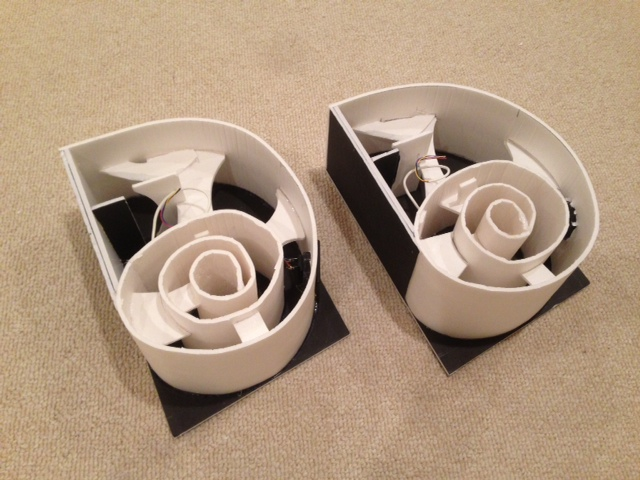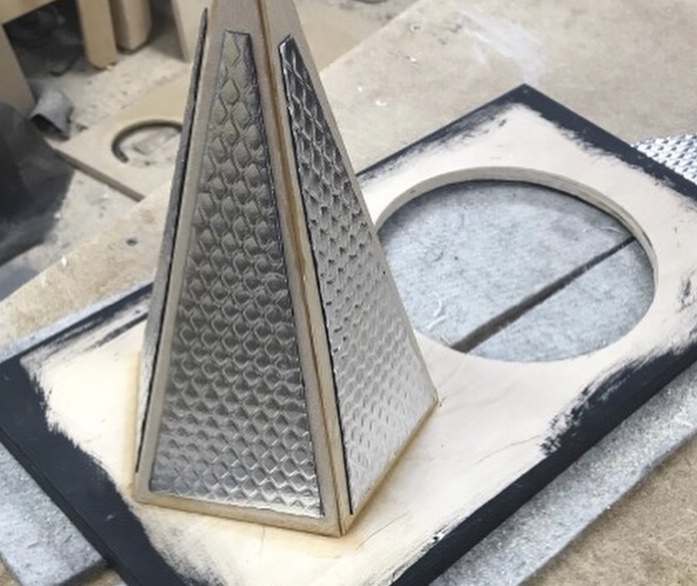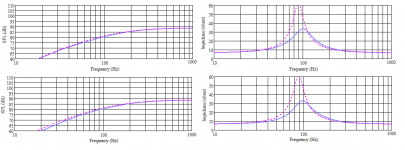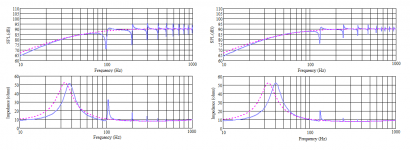My guess (in post 155) is that we are looking at a very long pipe relative to the lower limit of that little driver*. I doubt it was engineered much at all, except maybe to ensure that very expensive contraption wouldn't make matters too much worse. Or not worse than a damped sealed box of the same size.
Anybody able to do a quick Enrico Fermi estimation of what we are looking at in post 155?
But the Nautilus sure has lots of what the house realtor agents call "curb appeal"** when they are trying to flog an expensive house in a crowded market to buyers.
B.
*hey, long pipe, great idea....
** or kerb appeal
Anybody able to do a quick Enrico Fermi estimation of what we are looking at in post 155?
But the Nautilus sure has lots of what the house realtor agents call "curb appeal"** when they are trying to flog an expensive house in a crowded market to buyers.
B.
*hey, long pipe, great idea....
** or kerb appeal
Last edited:
I did run simulations, and conclude that a sealed exponential taper is superior in suppressing standing wave modes than a plain sealed box and tapers of other profiles. It was not a huge difference, but it was noticeable, and at the price level we are talking about even the smallest detail counts.
My guess (in post 155) is that we are looking at a very long pipe relative to the lower limit of that little driver*.
A very long pipe for a small driver will be an Onley Labyrinth and if not stuffed tin aperiodic will be a mess. One should never tune a (bass) TL significantly below Fs — GM suggest that that should be 0.707 x Fs.
dave
I did run simulations, and conclude that a sealed exponential taper is superior in suppressing standing wave modes than a plain sealed box and tapers of other profiles. It was not a huge difference, but it was noticeable, and at the price level we are talking about even the smallest detail counts.
Granting the precision of your analysis that finds only a modest difference in effectiveness, still vast difference in manufacturing cost between filling a little box with enough absorbent to deal with frequencies in the middle range as compared to the manufacturing cost (and vast mark-up) of making and sealing a labyrinthine contraption. Or alternatively, making that little box just wee bit bigger and stuffing it just a little bit more.
Manufacturers, including those represented in this thread, are forever looking for a "unique selling proposition" as the marketers say. Of all the issues in speaker building at any price level, standing waves in the middle range has got to be near the bottom of the list of tough challenges.
B.
A very long pipe for a small driver will be an Onley Labyrinth and if not stuffed tin aperiodic will be a mess. One should never tune a (bass) TL significantly below Fs — GM suggest that that should be 0.707 x Fs.
Yes, that's exactly what I am saying: that big snail in post 155 is not engineered according to the sacrosanct rules of MJK. Or that's my guess until somebody estimates the model.
As far as anybody should care, it just doesn't matter if it meets the sacrosanct rules of TL-land or not. If it sequesters suitably (as the Nautilus builders think it does), be happy.
My point is that (other than for subs) a TL or a Nautilus is just marketing puffery rather than an advance in the SOTA.
B.
Last edited:
… the sacrosanct rules of MJK...
Those “rules” are simulations of the real physics of the matter. Your statment is disingenuous.
dave
You had a great point. For this reason I had been hesitant to call these "transmission lines", but did so because everybody else believed they were.
A closed tube with an exponential profile is just another special enclosure shape, not unlike the sphere has certain desirable qualities as a cabinet. Tuning is not important in this usage (to sequester the back wave, but no desire whatsoever to change the front output).
A closed tube with an exponential profile is just another special enclosure shape, not unlike the sphere has certain desirable qualities as a cabinet. Tuning is not important in this usage (to sequester the back wave, but no desire whatsoever to change the front output).
I know I am really late to this thread, but I did have the opportunity to listen to the nautilus in an audio shop around 15-18 years ago. I remember thinking they looked more like abstract art than something I would want in my house. The thought of a pair of speakers that cost 10x more than my car was also a bit absurd. The sales guy was nice enough to let us play some Dave Matthews Band, NiN, Metallica and I do not remember much else that long ago. The part I remember the best was the next room over had a home theatre setup playing 'The Mask of Zorro' on a setup that was electrostatics in all locations. I vividly remember the scene where they were talking in a room where other people were eating, and you could hear all of the ambient noises like spoons clinking perfectly. I was astonished that there was so much detail in a movie that I had never known even existed before. Until that point the best speakers I had heard were probably the various Klipsh systems a friends father was obsessed with, and these were so much better to my ears that I immediately classed electrostatics as the holy grail to try and afford some day. (Still has not happened though, but mainly because of small children, high voltages, and that mixture)
But any ways, the nautilus was no more impressive than the other 4-5 other listening setups in various rooms in this show room. The giant lasting impact to a broke college student who only dropped into the place to buy 4 gauge power wire was the electrostatic setup, of which I have no idea sadly what brand they even were! I had forgotten about the nautilus entirely actually until this thread with the picture - the shape I remembered, the sound not so much.
But any ways, the nautilus was no more impressive than the other 4-5 other listening setups in various rooms in this show room. The giant lasting impact to a broke college student who only dropped into the place to buy 4 gauge power wire was the electrostatic setup, of which I have no idea sadly what brand they even were! I had forgotten about the nautilus entirely actually until this thread with the picture - the shape I remembered, the sound not so much.
....and these were so much better to my ears that I immediately classed electrostatics as the holy grail to try and afford some day. (Still has not happened though, but mainly because of small children, high voltages, and that mixture)
Funny, many of the ESL enthusiasts I know (and me too in 1966) had similar "Ah ha!" experiences. And like you, sometimes with years passing before we could get ESLs into our homes.
Just post a note in the Planar forum and your days of yearning will soon be over.
B.
Last edited:
Dave:
As I recall, like today, the Nautilus was mixed open and closed. Everything in the original nautilus was open ended except the bass.
Jared:
<< sigh >> yeah. I heard it with 2 stereo Krell amps (or was it 3?) per side with the active crossover. I was so not impressed. Mostly it sounded dry, and EQ'd bass shy.
As I recall, like today, the Nautilus was mixed open and closed. Everything in the original nautilus was open ended except the bass.
Jared:
<< sigh >> yeah. I heard it with 2 stereo Krell amps (or was it 3?) per side with the active crossover. I was so not impressed. Mostly it sounded dry, and EQ'd bass shy.
As I recall, like today, the Nautilus was mixed open and closed. Everything in the original nautilus was open ended except the bass.
If I was mistaken about all 4 closed, I wonder what might be the output from those 3 open ends?
I argued that they had to be closed end in post #24 by comparing it to HLCD in reverse. But in a nutshell you get TL turbulence noise in the same way you get port turbulence noise from a port opening of insufficient diameter of a bass reflex enclosure. The solution is to close the end.
Note also that the tweeter was certainly not tuned. Tweeter's length looked way too long to be tuned, but then a closed exponential TL does not depend on tuning to do its job sequestering the back wave.
Thank you Erik for starting this good thread and get all of us thinking. Some of the respondents think a similar effect can be achieved by using quarter-wave transmission lines as they have been getting a great sound from them. I do not agree with the "I already knew the trick and I already knew what to do" answers. Nautilus is clearly not the same as open-end quarter-wave transmission lines, and I believe we can all learn new tricks by identifying the differences. I was not doubting for a second or questioning the sonic superiority of the great number of speakers any of you has built - I was merely saying you were not building the Nautilus or anything remotely similar, and that your experience with TLs may not directly apply.
As I recall, like today, the Nautilus was mixed open and closed. Everything in the original nautilus was open ended except the bass.
It's too long since I last saw a pair to remember if the three upper pipes were 1/4 wave or 1/2 wave. I thought they were all sealed, but stand corrected if otherwise. The tweeter pipe will likely have been cosmetic if open, given the delicate nature of the loadings involved for these units. Otherwise, assuming the pipes were designed appropriately to the configuration & they're targeting suppression of the back wave, either quasi-aperiodic 1/4 wave or a 1/2 wave sealed line works fine. Basic example attached, tapered pipes identical other than the upper being a 1/4 wave (terminus open) & the lower a 1/2 wave (sealed pipe). These are not optimised & purely for the sake of example. However, as you can see, if you're primarily interested in suppressing the back wave, they both do a similar job. I haven't time to add the displacement, impulse etc. plots, but for the purposes intended for these pipes (please note caveat) there isn't a great deal between them. All fairly standard, no surprises here.
Attachments
Last edited:
I played around with a spiral sealed rear chamber for a while, it does work and looks cool. It measures flat and free of rear wave distortions like same driver in an OB.
For a mid-tweetL

More here:
The Nautaloss Ref Monitor
But in the end, for mid-tweeter, a triangular or five-sided tall pyramidal backa chamber stuffed with fiberglass, works just as well and is easier to make and more compact.
10F/8424 & RS225-8 FAST Ref Monitor

For a mid-tweetL

More here:
The Nautaloss Ref Monitor
But in the end, for mid-tweeter, a triangular or five-sided tall pyramidal backa chamber stuffed with fiberglass, works just as well and is easier to make and more compact.
10F/8424 & RS225-8 FAST Ref Monitor
There is no single answer to that as taper is only one variable & it depends what is happening with the others. Back in post 45 I provided a comparative graph between two 1/2 wave lines of identical axial length (this results in different 1/2 wavelength resonant frequencies) & volumes. They were deliberately left completely undamped, and were end-loaded to ensure the standing waves had maximum excitation & were as obvious as possible.
Plots attached again here for simplicity. Left column = untapered, right column tapered to a terminus of nominally zero area.
Plots attached again here for simplicity. Left column = untapered, right column tapered to a terminus of nominally zero area.
Attachments
Last edited:
- Home
- Loudspeakers
- Multi-Way
- Was Nautilus bunk?

